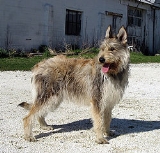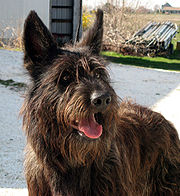
Berger Picard
Encyclopedia
| Berger Picard overview | ||
|---|---|---|
| Weight: | 50-70 lbs. (23–32 kg.) | |
| Height: | Females 21.5-23.5 inches Males 23.5-25.5 inches (55–66 cm.) | |
| Coat: | Harsh, crisp, thick strong hair, about 2-2.5 inches (5–6 cm.) | |
| Litter size: | 2-10 pups | |
The Berger Picard is a medium-sized, well-muscled dog, slightly longer than tall with a tousled yet elegant appearance. Their ears are naturally erect, high-set and quite wide at the base. Their eyebrows are thick, but do not shield their dark frank eyes. They are known for their smile. Their natural tail normally reaches to the hock and is carried with a slight J-curve at the tip. Their weather-proof coat is harsh and crisp to the touch, not excessively long with a minimal undercoat. Coat colors fall into two colors, fawn and brindle with a range of shade variations.Les Amis du Berger Picard Club de Race affilie a la Societe Centrale Canine
Temperament
The Berger Picard's attributes include a lively, intelligent personality and a sensitive and assertive disposition that responds quickly to obedience training. By and large, Picards are laid back and mellow but they are known for having a stubborn streak and being reserved towards strangers. They require a lot of socialization during the first two years of their lives.Picards are energetic and hard working, alert, loyal and sweet-tempered with children. They are happiest when they have a job to do. They also have a protective nature, making them good guard dogs. However, they are not excessive barkers. Some Picards are notoriously picky eaters, and it may be difficult to decide on a diet that you and the dog agree on.
The breed also has a well-developed sense of humor, making them an endearing companion, and they continue to be used very effectively as both sheep and cattle herder in their native land and elsewhere.
Like many herding breeds, Picards require human companionship and lots of it. Since they can be demonstrative to their owners and enthusiastic friends towards other animals, formal obedience training and plenty of positive socialization is a must. Athletic, loyal and filled with a desire to work a long day, the breed excels in any "job" as long as enthusiasm and praise is a part of the task.
Health
Berger Picards due to lack of over breeding are a relatively healthy, disease free breed. Hip dysplasia is known. A reputable breeder will have hips certified by the Orthopedic Foundation for Animals or by Penn-Hip with the results posted on the OFFA database found at http://offa.org/search.html?btnSearch=Advanced+Search Eyes will be certified for hereditary diseases through the Canine Eye Registration Foundation, results should also be published on the OFFA database.The breed's life expectancy is 13 to 14 years.
Exercise and Activities
Bred to work the fields, Picards are very athletic and revel in exercise. A good deal of exercise is therefore a must for this breed. Otherwise boredom will give way to destructive doggie behavior and rowdy play. They enjoy swimming, running beside a bike, and nice long walks. The Berger Picard makes an excellent jogging companion. The breed's intelligence and sensitivity have made it increasingly popular in dog sports such as agilityDog agility
Dog agility is a dog sport in which a handler directs a dog through an obstacle course in a race for both time and accuracy. Dogs run off-leash with no food or toys as incentives, and the handler can touch neither dog nor obstacles...
trials, Tracking
Tracking trial
A Tracking trial is an event to encourage dogs to make use of their strongest facility, the ability to follow a scent trail. The competition emulates the finding of a lost person or article in a situation where the performance of the dog can be fairly assessed...
, obedience
Obedience training
Obedience training usually refers to the training of a dog and the term is most commonly used in that context. Obedience training ranges from very basic training, such as teaching the dog to reliably respond to basic commands such as "sit", "down", "come", and "stay", to high level competition...
, showmanship
Dog showmanship
Dog showmanship is a set of skills and etiquette used by handlers of dogs in a dog competition. Dog showmanship is not a competition in itself but a qualification of the handler to present a dog to its best advantage. Skills are technical as well as artistic...
, Schutzhund
Schutzhund
Schutzhund is a dog sport that was developed in Germany in the early 1900s as a breed suitability test for the German Shepherd Dog. The test would determine if the dog displayed the appropriate traits and characteristics of a proper working German Shepherd Dog...
, Flyball
Flyball
Flyball is a dog sport in which teams of dogs race against each other from a start/finish line, over a line of hurdles, to a box that releases a tennis ball to be caught when the dog presses the spring-loaded pad, then back to their handlers while carrying the ball.Flyball is run in teams of four...
, Lure coursing
Lure coursing
Lure coursing is a sport for dogs that involves chasing a mechanically operated lure. Competition is usually limited to dogs of purebred sighthound breeds.-Lure course:...
, French Ring Sport and herding
Herding
Herding is the act of bringing individual animals together into a group , maintaining the group and moving the group from place to place—or any combination of those. While the layperson uses the term "herding", most individuals involved in the process term it mustering, "working stock" or...
events. Herding
Herding
Herding is the act of bringing individual animals together into a group , maintaining the group and moving the group from place to place—or any combination of those. While the layperson uses the term "herding", most individuals involved in the process term it mustering, "working stock" or...
instincts and trainability can be measured at noncompetitive herding tests. Berger Picards exhibiting basic herding instincts can be trained to compete in herding trials.

Living conditions
Despite being more suited for being outdoors, Picards can do surprisingly well in city life provided they are given enough energy-releasing exercise. However, the Picard always tries to stay close to its owner and family, so when given a choice between being alone in a big yard or inside with its master the Picard would rather be with his "shepherd." Inside the house the Picard is usually a very quiet dog, waiting for its time to go out to run, play and sniff around. They are very loyal and enjoy a lot of attention and may suffer from separation anxiety (even if being left alone inside for short periods of time).Grooming
The Berger Picard is a low maintenance dog. The rough, tousled coat can mat if not brushed on a regular basis (once every other week) but the coat does not require special care to yield its rustic appearance. Bathing is rarely done. Their fur should never be trimmed except maybe hand stripping the ears. They are not profuse shedders and have little "doggie odor".History
Thought to be the oldest of the French Sheepdogs, the Berger Picard was brought to northern France and the Pas de Calais, in the 9th century by the Franks.Some experts insist that this breed is related to the more well-known Briard
Briard
The Briard is a large breed of dog, one of many herding breeds. The Briard has been known for some centuries. Charlemagne, Napoleon, Thomas Jefferson, and Lafayette all owned Briards. This ancient sheep guard and herder has also been used by the French Army as a sentry, messenger, and to search for...
and Beauceron
Beauceron
The Beauceron is a guard dog and herding dog breed falling into the working dog category whose origins lie in the plains of Northern France. The Beauceron is also known as Berger de Beauce or Bas Rouge .-Appearance:This breed stands 61 to 70 cm in height and weighs 30 to 45 kg The...
, while others believe it shares a common origin with Dutch and Belgian Shepherds. Although the Berger Picard made an appearance at the first French dog show in 1863, the breed's rustic appearance did not lead to popularity as a show dog.
The breeding stock of the Berger Picard, was decimated by the ravages of World War I and World War II. With its population concentrated on the farms of north-eastern France, trench warfare in the Somme reduced the breed to near extinction.
The Picard's easy care and mellow, yet mischievous, temperament have started the breed back on the road to recovery. Nevertheless its numbers are still limited, even in its native country. As mentioned previously, today in France there are approximately 3500 dogs and in Germany approximately 500 of this breed. At present there are approximately 300 Berger Picards in the United States and Canada.
The Berger Picard was recognized by the United Kennel Club on January 1, 1994. In 2006, the Berger Picard Club of America was formed to protect and promote the breed in the United States. The Berger Picard has been recorded in the Foundation Stock Service of the American Kennel Club since April 2007. On October 12, 2011, The American Kennel Club chose the Berger Picard Club of America as the official parent club, as the breed moves towards full recognition.http://www.akc.org/pdfs/about/board_minutes/1011.pdf
Interesting Facts
- Sheepdogs resembling Berger Picards have been depicted for centuries in tapestries, engravings and woodcuts. One renowned painting, in the Bergerie Nationale at Rambouillet, the National Sheepfold of France, dating to the start of the 19th century, shows the 1st Master Shepherd, Clément Delorme, in the company of a medium-sized, strong-boned dog with mid-length crisp coat and naturally upright ears, resembling in many ways a Berger Picard of today.
- The first Berger Picards were shown together in the same class with Beaucerons and Briards in 1863 but it was more than 50 years later in 1925 that the Picard was officially recognized as a breed in France.
- Berger Picards, with their crisp coats, were reportedly used to smuggle tobacco and matches across the Franco-Belgian border. The tobacco would be put in goatskin pouches, hairy side up, and attached to the dog's shaven back. From a distance, dogs carrying such loads would not draw attention, particularly at dusk or at night.
- Berger Picards can be seen in three current movies, "Because of Winn Dixie," "Daniel and the Superdogs," and "Are We Done Yet?" but Picards are often mistaken for another canine actor, the Wirehaired Portuguese Podengo Medio, another scruffy looking rare breed.
Additional Reading
- The Berger Picard (French), written by Joel Herreros, published by De Old
- Les Berger Francais (French), written by Philippe De Wailly and Alain Dupont, published by Solar, September 12, 1999, ISBN 2263026584

